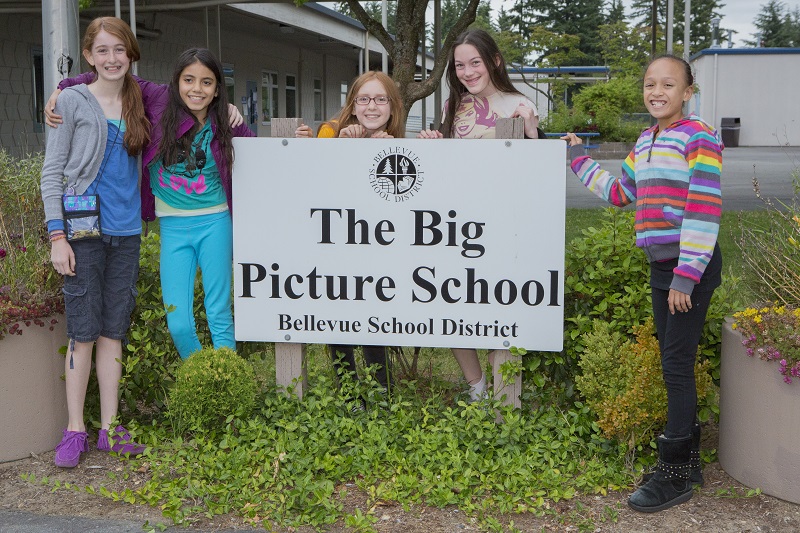
Big Picture School, Bellevue, Washington, United States
Last fall, Bellevue School District opened a school with a new format – The Big Picture School. It is a model that is followed in over 100 schools in the U.S., Australia, Canada, Israel, and the Netherlands. The approach was first applied in 1995 and is based on three principles: that learning must be based on the interests and goals of each student; that a student’s curriculum must be based relevant to people and places that exist in the real world; and that a student’s abilities must be authentically measured by the quality of her or his work.
A group from Eastside Pathways took a field trip to visit this new school (located at the site of the former Robinswood Middle and High School) and sat down with Principal Bethany Spinler to learn a little more.
We learned that the Big Picture approach was selected last year after a rigorous review of a number of national models. The goal of the effort is to provide a high-quality learning environment to students that are looking for a different experience from the typical middle and high school models. High school students work at internships two days each week at organizations related to their interests. Teachers (called advisors) teach the same group of students for multiple years and work closely with family and community members. Core curriculum and advisory content focus on college and career readiness in a small and personalized environment.
In our walk through the school, we dropped in a 6th grade classroom. The room was abuzz with energy, students working in small groups. The instructor explained that they were about to deliver presentations on health-related topics. Before that was possible, the students were defining the rubric that would be used to grade the presentations. In a science class, we learned that students had selected topics based on experiences in their own community. One student had connected with a local food processor, discussing steps they take to minimize their environmental impact and the chemical underpinnings of those processes.
Big Picture finds a way to link student learning to their community and to their interests in a way that elevates the relevance of the subjects they study.
Kristen Edelhertz, a new Big Picture School parent, shares her perspective.
In September 2011 we took a leap of faith. We enrolled our 6th grader in the Big Picture School, the new ‘choice’ school in the Bellevue School District. As the Big Picture School opened its doors to students for the first time, we opened our minds to new possibilities. The Bellevue Big Picture School is based on the national Big Picture Learning model. What captured our attention as parents and the attention of our 6th grade son? Problem-based learning that is relevant to the real world, standards-based grading, focus on 21st century skills, students responsible for their own learning, leadership opportunities, community mentors, and local business internships for high school students. Our son works on projects that integrate subject matter and are clearly relevant to the real world. “Why do I have to do this?” is now answered every day. Standards-based grading clearly identifies the areas that he needs to focus on and re-work, if necessary, to achieve or exceed standard. He has a wonderful relationship with his advisor, who will be with him through 8th grade. With his advisor, my son has explored who he is and what interests him and has begun to explore careers as well. He has led his own student/advisor/parent conferences and developed goals for himself. Now we see him taking more and more responsibility for meeting those goals and his overall success in school. This environment has engaged him in his learning in a way we are not sure would be possible in a traditional school.
The Bellevue Big Picture School is a secondary (6th-12th grade) school-of-choice that began with 125 students in 6th and 9th grade last September. Nationally, Big Picture schools have a graduation rate of 92% and a college acceptance rate of 95%, succeeding especially with students of color and students living in poverty. For the 2012-13 school year, enrollment has begun for 6th, 7th, 9th and 10th graders.

